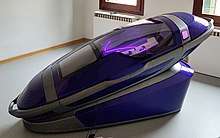Sarco device
The Sarco device (or Pegasos) is a euthanasia device or machine consisting of a 3D-printed detachable capsule (or coffin) mounted on a stand that contains a canister of liquid nitrogen to commit suicide through inert gas asphyxiation. "Sarco" is short for "sarcophagus".[1][2] It is used in conjunction with an inert gas, nitrogen, which prevents the panic, sense of suffocation and struggling before unconsciousness, known as the hypercapnic alarm response [3]:45 caused by the presence of high carbon dioxide concentrations in the blood.[3] The Sarco was invented by euthanasia campaigner Philip Nitschke in 2017.

| Suicide |
|---|
|
Social aspects |
|
Related phenomena |
|
Organizations |
| Part of a series on |
| Euthanasia |
|---|
| Types |
| Views |
| Groups |
| People |
| Books |
| Jurisdictions |
| Laws |
| Alternatives |
| Other issues |
History
The Sarco is an expansion of the hypoxic death provided by a suicide bag. Many people will not consider euthanasia by suicide bag for aesthetic reasons, or feel claustrophobic inside a bag. Nitschke calls this the "plastic bag factor".[4] The Sarco provides a solution to these objections.
Mechanics
Access to the Sarco will be controlled by an online test to gauge mental fitness. If applicants pass, they receive an access code to a Sarco device that works for 24 hours.[5]
Users of the Sarco can choose either a dark or transparent view from the capsule. The transparent view would be chosen if they wish to transport the machine to a particular location to see a certain vista from the machine.[6] The inventor feels that "where you die is certainly an important factor".[5]
The capsule of Sarco provides for a rapid decrease in oxygen level while maintaining a low level of carbon dioxide. On activation, 4 litres (1.1 US gal) of liquid nitrogen causes the oxygen level to drop silently to less than 5% in less than one minute. According to Nitschke, 'The occupant presses the button and the capsule is filled with nitrogen. He or she will feel a bit dizzy but will then rapidly lose consciousness and die'.[1]
Design and manufacture
The design of the device was a collaboration between Nitschke and Dutch industrial designer, Alexander Bannink.
Sarco is 3D-printed in sections measuring 1,000 by 500 by 500 millimetres (39 by 20 by 20 in). The design software allows for devices of different sizes to be made according to the client's dimensions. Nitschke has said that the design is intended to resemble that of a spaceship, in order to give users the feel that they are traveling to the "great beyond".[7]
Nitschke plans to release the open source plans for the Sarco by 2019.[5]
Criticism
Critics have described the device as "just a glorified gas chamber", and others have raised concerns that it is glamourising suicide.[8]
References
- "Nitschke's 'suicide machine' draws crowds at Amsterdam funeral fair". The Guardian. 15 April 2018. Archived from the original on 15 April 2018. Retrieved 15 April 2018.
- Overington, Caroline (25 November 2017). "Philip Nitschke invents suicide capsule with 3D printer". The Australian. News Corporation. Retrieved 25 November 2017.
- Nitschke, Philip; Stewart, Fiona (2016). "Hypoxic Death and the Exit bag". The Peaceful Pill Handbook. Exit International US Limited. ISBN 9780975833919.
- "Meet The Elon Musk Of Assisted Suicide, Whose Machine Lets You Kill Yourself Anywhere". Newsweek. 12 January 2017. Archived from the original on 9 April 2018. Retrieved 8 April 2018.
- Nitschke, Philip (5 April 2018). "Here's Why I Invented A 'Death Machine' That Lets People Take Their Own Lives". Huffington Post. Archived from the original on 5 April 2018. Retrieved 6 April 2018.
- De Jong, Marjolein. "An Australian Doctor Built a Machine That Helps People Die". Vice. Retrieved 21 April 2019.
- Erickson, Amanda (15 April 2018). "An euthanasia expert just unveiled his 'suicide machine' at an Amsterdam funeral fair". The Washington Post. Retrieved 21 April 2019.
- Cuthbertson, Anthony (17 April 2018). "Suicide machine that could be controlled by the blink of an eye sparks euthanasia debate". The Independent. Retrieved 21 April 2019.